Effective Ways to Deter Possums from Your Property
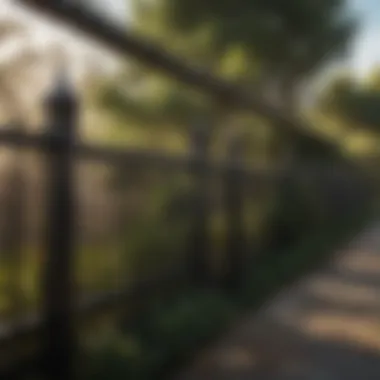

Intro
Possums are often viewed as a nuisance by homeowners. Understanding their biology and behavior is the first step in effectively deterring them from invading residential properties. This article provides insights into the methods that can be employed to keep these animals at bay. From environmental modifications to physical barriers, a variety of strategies can be utilized.
Understanding the Pest
Identification
Possums are marsupials native to Australia and nearby regions. The most common species found in residential areas is the Virginia opossum. They have distinctive physical features: a pointed snout, long tail, and large ears. Recognizing these traits helps in determining whether possums are present on your property. Multiple signs suggest their presence, including droppings, scaled tracks, and even noise at night.
Life Cycle
The life cycle of a possum involves several stages. They breed in spring. After a gestation period of about 12 days, the young are born and crawl into the mother’s pouch. They will stay there for around 70 days before they complete weaning. Knowing this can help in planning preventive measures. For example, adult possums typically require a safe habitat for their young, so removing possible nesting spots is crucial.
Pest Prevention Strategies
Environment Modification
Altering your environment is one of the most effective ways to deter possums. Here are some methods:
- Remove food sources: Secure garbage cans and pick up pet food.
- Trim vegetation: Cut back tree branches to prevent easy access to roofs.
- Seal entry points: Close openings in attics, basements, and garages.
Implementing these changes can significantly reduce the attraction of your property to possums.
Physical Barriers
Building physical barriers can offer an additional layer of protection. Consider the following:
- Fencing: Install a tall fence (at least six feet) with a bent top to prevent climbing.
- Netting: Use wire mesh around gardens and vulnerable plants.
"The best offense is a good defense." This principle is very applicable in preventing possums from accessing residential areas.
Control Methods
Chemical Control
Chemical repellents can be used to deter possums, although they should be employed responsibly. Many products are available in the market, containing natural or synthetic ingredients. Always read labels for safety information and application instructions.
Biological Control
Introducing natural predators may be an option in some cases. However, this method requires careful consideration of local ecosystems. It is essential to consult professionals to avoid unintentional consequences.
Homeowners must balance the desire to keep their property pest-free with ethical considerations in possum management. Effective deterrence strategies can help maintain a tranquil home environment.
Understanding Possums
Understanding the biology and behavior of possums is crucial for effective management. Knowledge of these animals aids homeowners in creating a less appealing environment for them. Possums are marsupials with unique traits that set them apart from other wildlife. Being aware of their characteristics can greatly influence how preventative measures are designed and implemented.
Biological Characteristics of Possums
Possums are small to medium-sized marsupials. They belong to the family Didelphidae. Typically, they have a pointed snout, large ears, and a prehensile tail which helps them in climbing. Possum fur varies in color, usually grayish or brownish, aiding camouflage in natural settings. These biological traits enable them to thrive in various environments, making it essential to consider their physical adaptations when planning deterrent strategies.
Possums are generally nocturnal, meaning they are most active during the night. Their diet is omnivorous, consuming fruits, vegetables, insects, and occasionally small animals. This dietary versatility allows them to exploit a range of food sources, which can lead them to residential areas where food is plentiful and easily accessible.
Behavioral Patterns
Possums exhibit specific behaviors that can be key in understanding how to deter them. As solitary animals, they tend to forage alone rather than in groups. Infact, they are often shy and will avoid confrontation. When threatened, a possum may play dead, a behavior known as thanatosis. This reaction serves as a defense mechanism, discouraging potential predators. Understanding these behaviors is instrumental in shaping humane deterrence methods, as they show a general reluctance to engage in conflict.
In addition to being nocturnal foragers, possums are known for their adaptability. They will explore their surroundings, including human dwellings, which can lead to property invasions. Homeowners may notice signs of possum activity, such as droppings or shredded food waste. Recognizing such patterns can help in assessing and monitoring potential problems before they escalate.
Habitat Preferences
Possums thrive in diverse habitats, but they tend to prefer areas that provide access to food and shelter. Wooded areas, urban parks, and gardens often attract them. Their ability to adapt allows them to live in suburban neighborhoods, where human activities converge with natural settings.

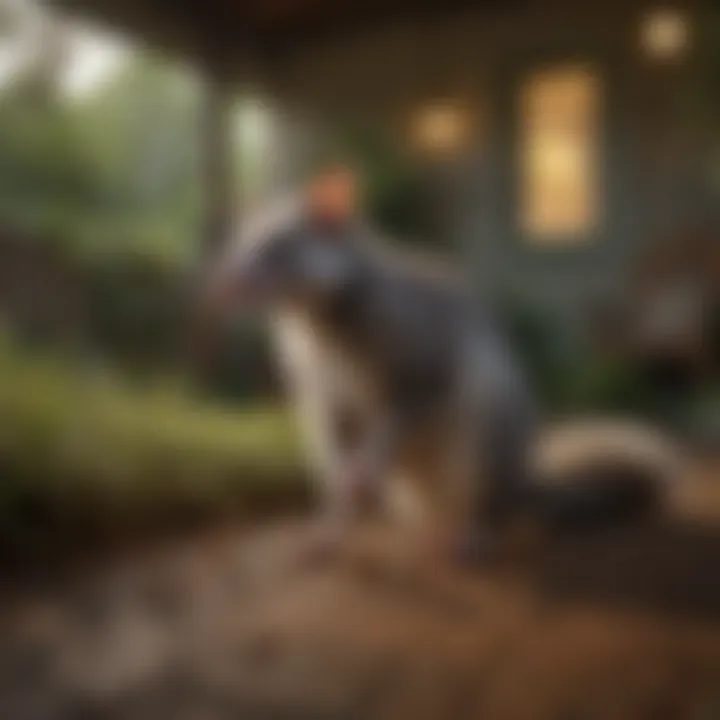
They typically seek places to nest and find shelter in attics, under porches, or in thick vegetation. Ensuring that these spaces are inaccessible is vital in keeping possums at bay. Homeowners should evaluate their properties for common shelter opportunities that may appeal to possums. For instance, fallen debris and overgrown shrubs can serve as attractive hideaways for these animals, necessitating proactive measures to manage potential risks.
Knowing these key aspects of possum behavior, biology, and habitat can aid homeowners in effectively diminishing the chances of possums invading their property. By understanding the nature of these creatures, appropriate strategies can be developed to ensure a possum-free environment.
Legal Considerations
Understanding the legal considerations involved in managing possums is essential for homeowners. Possums play a role in the ecosystem, and protecting their rights is often a legal obligation. Failing to adhere to relevant laws can result in penalties. Therefore, it is important to familiarize oneself with local regulations to ensure that efforts to deter possums remain compliant.
Local Wildlife Protection Laws
Many regions have wildlife protection laws that aim to conserve native species. Possums are often included in these laws due to their ecological significance. These laws vary by location, so homeowners must consult local wildlife agencies for specific guidelines.
Common protections for possums may include:
- Regulations against illegal trapping or killing.
- Guidelines for feeding or handling wild animals.
- Specific seasons or habitats where interferance is prohibited.
Failure to comply with these laws can lead not only to harm to the possums but also to fines or legal actions against homeowners. Therefore, being aware of local wildlife protection laws is crucial for responsible property management.
Permits and Ethical Management
When it comes to managing possums, obtaining the right permits may be necessary. Many jurisdictions require permits for trapping or relocating wildlife. This process ensures that the management of possums follows ethical standards and respects their welfare.
Homeowners should consider the following points:
- Understand the permit requirements. Check local regulations for any permits required for trapping or relocation.
- Engage professionals when necessary. If a possum problem escalates, it may be wise to consult with wildlife control experts.
- Focus on humane methods. Ethical management involves using non-lethal methods to deter possums, such as repellents or physical barriers.
Balancing legal responsibilities with effective possum management creates a sustainable approach. Homeowners can protect their property while respecting wildlife laws, leading to conservation efforts and enhanced neighborhood harmony.
Preventative Measures
To effectively deter possums from invading your property, preventative measures represent the first line of defense. Implementing these strategies not only helps in minimizing potential conflicts but also fosters a proactive approach to wildlife management. By focusing on behavioral patterns and habitat preferences of possums, homeowners can create an uninviting environment, thus reducing the likelihood of an encounter.
Several elements come into play when considering preventative measures. One key factor is understanding that possums are opportunistic feeders and can thrive in environments where food is easily accessible. Reducing food sources is critical. Another important aspect is securing potential shelter areas, as possums often look for dark and hidden spaces to reside. Overall, it is about modifying the environment to make it less appealing to these animals.
Securing Trash Bins
Properly managing your waste is essential to deterring possums. When trash bins are left unsecured, they attract not just possums, but a variety of wildlife. This can lead to not only property damage but also health risks. To prevent this, it is highly recommend to invest in sturdy, animal-proof bins. These bins should have tight-fitting lids and ideally be made from durable materials. Positioning the bins in a location that is away from any cover can make a significant difference as well.
"One of the simplest steps to keep possums at bay is securing your trash. Possums are attracted to easy food sources."
Preventing Access to Pet Food
Possums are likely to be drawn to pet food if it is left outside. To minimize this risk, it is wise to feed pets indoors, particularly in the evenings when possums are most active. This simple act can reduce the temptation for possums to venture into your space. If feeding outside is unavoidable, consider using elevated feeding stations that can deter larger wildlife. Remember that a clean area after feeding will help as well, removing any uneaten food promptly.
Implementing Garden Barriers
Creating physical barriers around gardens and plants can serve as an effective deterrent. Using fencing is practical, but it must be done correctly. Ideally, the fence should be at least four feet high and have an underground component to prevent digging under it. Additionally, barriers can include plants that possess a natural resistance to pests or those that are unappealing to possums, such as certain herbs. Using these barriers can help protect your garden while also making your property less inviting to these critters.
Environmental Modifications
Environmental modifications are essential in the effort to deter possums from your property. These strategies focus on altering the physical landscape and surroundings in ways that make them less appealing to these creatures. By reducing shelter opportunities, managing plant selections, and optimizing lighting conditions, homeowners can create a less hospitable environment for possums. This approach not only decreases the likelihood of possums taking up residence but also promotes a more harmonious residential setting.
Eliminating Shelter Opportunities
Possums seek safe and secure places to nest. Consequently, identifying and eliminating potential shelters is critical. Start by clearing away any clutter, such as piles of wood, leaves, or old furniture, which may provide hiding spots. Close access to hollow trees or abandoned structures that could serve as nests. Consider trimming overgrown vegetation that can create hiding spots.
The more open your garden area, the less likely possums will feel safe enough to visit.
Properly sealing basements, garages, and sheds ensures they are not appealing options as well. Moreover, creating a neat and tidy space means possums will have a harder time finding places to hide.
Managing Plant Selections
Certain plants can attract possums, thus understanding what plants to choose is vital. Avoid planting species that serve as food sources for possums, including some fruits and vegetables. Instead, focus on using less palatable native plants, which can also enhance the natural beauty of your garden. Not only will these plants be less attractive to possums, but they will provide a resilient habitat for local wildlife.
Here are some examples of less attractive plants:
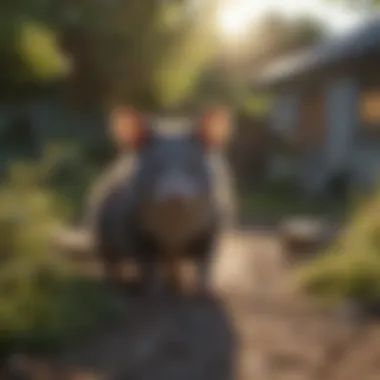
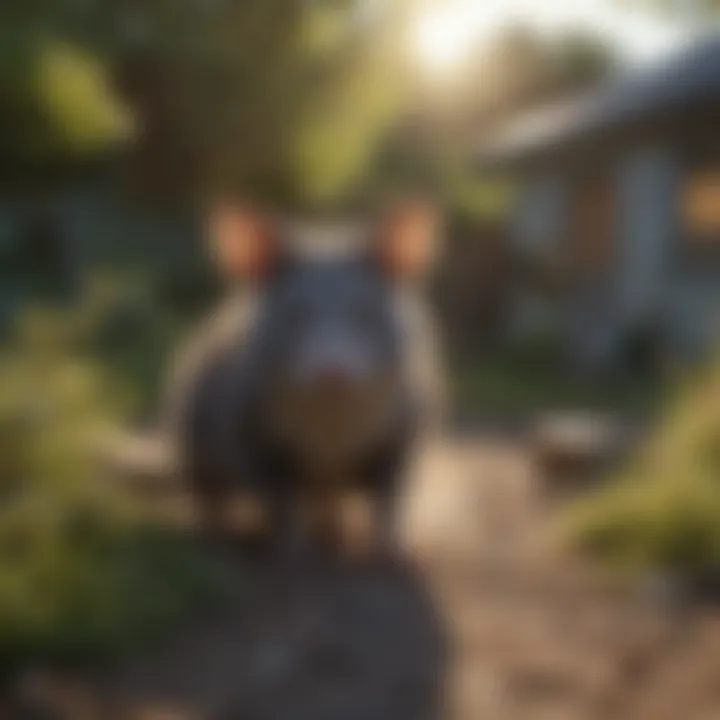
- Lavender
- Eucalyptus
- Boxwood
In addition, removing fruits that have fallen to the ground will reduce food sources. This preventive measure discourages possums from visiting your garden in the first place.
Lighting Strategies
Lighting can play a significant role in discouraging possums. These nocturnal animals prefer dark environments. By installing motion-sensor lights around potential entry points or in areas where possums are frequently observed, you can create a less inviting atmosphere for them. Bright, sudden lights can startle possums, prompting them to stay away from your property altogether.
To enhance effectiveness, consider the following approaches for your lighting strategy:
- Use bright white LED lights for maximum visibility.
- Position lights strategically near access points, such as doors or gates.
- Ensure that these lights are operational and well-maintained.
Physical Barriers
Physical barriers play a crucial role in preventing possums from invading residential properties. By creating obstacles, homeowners can effectively deter these animals from accessing areas where they do not belong. Physical barriers are not just about distraction; they provide a solid defense against unwanted incursions. Building a fence or employing other barriers can significantly lower the chance of possum visits. The effectiveness of these measures often stems from their physical nature, as they rely on the basic instinct of possums to navigate through their environment while seeking food and shelter.
Fencing Solutions
Types of Fencing
There are several types of fencing that can be utilized to keep possums away. Chain link fencing is a popular choice because it’s durable and provides a transparent barrier. It is straightforward to install and has the necessary height to prevent climbing. Another effective option is wooden fencing, especially when it is solid and tall. Solid barriers limit visibility, which can discourage possums looking for a route through your yard. One key characteristic of these durable materials is their strength, ensuring they resist the efforts of a determined possum. However, wooden fences may require regular maintenance to prevent decay.
Height and Depth Considerations
When constructing fences, height and depth are paramount. Possums are agile climbers and can scale lower fences with ease. A height of at least six feet is advisable, as it makes it difficult for them to jump over. Additionally, the fence should extend below ground level by about one foot. This prevents them from burrowing beneath it to gain access to the property. The unique feature of this method is its dual-barrier effect, providing two levels of protection. While this approach can be very effective, it might result in higher costs and more labor during installation.
Maintenance of Fencing
Regular maintenance of fencing is essential to ensure its efficacy. Over time, wear and tear can compromise the integrity of the fence. Checking for gaps or weak spots regularly allows for prompt repairs, keeping the barrier strong. This is a beneficial aspect since minor repairs can prevent major issues later. One advantage of maintaining fencing is that it can prolong its life significantly, thus offering prolonged protection against pests like possums. If left unchecked, even small holes can become entry points, nullifying the hard work put into building the barrier.
Installing Roof Vents and Screens
Another critical aspect of physical barriers includes installing roof vents and screens. These additions can protect spaces such as attics and roof voids, which possums often find appealing for nesting. In terms of effectiveness, screens made from sturdy wiring can keep these animals out while still allowing for ventilation. The limitations of this method need to be considered, as improperly installed vents can fail to deter possums. Addressing these gaps can better fortify your home against unwanted guests and contribute to overall property security. By ensuring that all roofing areas are secured, homeowners create a more inhospitable environment for possums.
Natural Deterrents
Understanding natural deterrents plays an important role in managing possum populations. These methods rely on the natural behavior of possums and incorporate elements that make the environment less inviting for them. By using plant-based repellents and predator urine products, homeowners can create a less favorable habitat for possums while working in harmony with nature. These options often have fewer environmental risks compared to harsh chemicals, making them a safer choice for families and pets.
Plant-Based Repellents
Plant-based repellents derive from specific plants known to deter possums due to their smell or taste. For instance, using plants like lavender or rosemary can create an aromatic barrier that keeps these animals at bay. Besides, creating borders of pungent herbs around gardens and entry points can discourage possums from entering these areas.
Benefits of using plant-based repellents include:
- Safety for children and pets: Unlike chemical solutions, plant-based repellents pose less risk.
- Environmental sustainability: These products often consist of natural materials, reducing harm to the environment.
- Aesthetic enhancement: Many plants serve as decorative elements that can beautify your garden.
Homeowners should consider the following when implementing plant-based repellents:
- Choose appropriate species: Select plants that thrive in the local climate and soil conditions.
- Placement matters: Strategically position these plants near areas frequented by possums.
- Regular maintenance: Ensure that plants are healthy, as wilted or dead plants may lose their repellent properties.
Predator Urine Products
Predator urine products can be an effective measure in deterring possums. These products are based on the scent of a predator, such as foxes or coyotes. The smell triggers a natural survival instinct in possums, warning them of potential danger nearby. As such, the presence of predator urine can effectively keep possums away from your property.
Utilizing predator urine products offers various benefits:
- Highly effective: The strong scent can disrupt possum’s natural behaviors and force them to seek safer habitats.
- Easy application: These products often come in spray bottle form, making application straightforward and quick.
- Long-lasting effects: Most predator urine products are designed to persist, providing ongoing protection against intrusions.
Considerations when using predator urine include:
- Reapplication after rainfall: Rain can wash away scent, so reapply after wet weather.
- Combine with other methods: For enhanced effectiveness, consider pairing predator urine with other deterrent strategies.
- Purchase from reputable sources: Ensure that the quality and sourcing of the urine products are trustworthy to maximize effectiveness.
By employing natural deterrents like plant-based repellents and predator urine, homeowners can effectively manage possum populations safely and sustainably. Understanding these methods equips property owners with effective tools to maintain a possum-free environment.
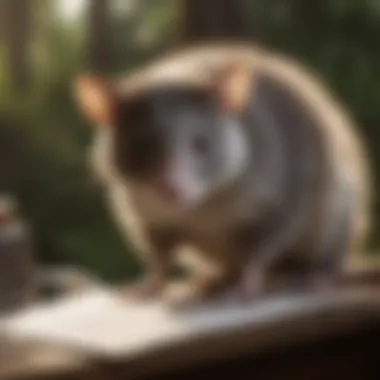
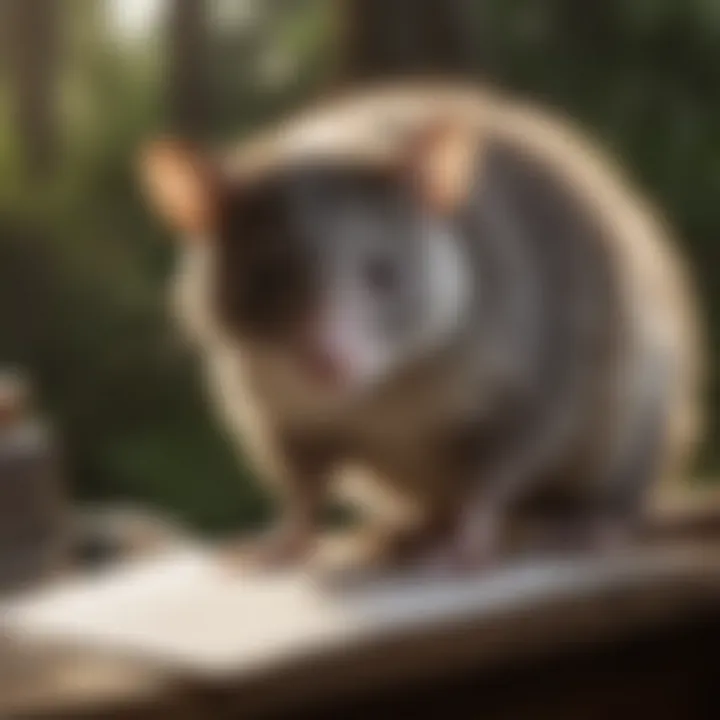
Reactive Measures
The management of possum populations often requires a proactive approach. However, when prevention fails, it becomes crucial to apply reactive measures. These measures can effectively minimize the impact of possums on your property. They not only address immediate concerns but also contribute to more sustainable solutions over time. Importantly, this approach emphasizes humane methods, ensuring the well-being of the animals involved while still fulfilling the needs of the property owner.
Humane Trapping Techniques
Humane trapping is one of the most effective reactive measures for solving possum-related problems. This technique involves using traps designed to capture possums without causing injury. Choosing the right type of trap is essential. The traps should be spacious enough to prevent stress to the animal but secure enough to prevent escape. You can find several traps designed specifically for possums at local hardware stores or online.
When using traps, placement is key. Setting traps in areas where possums are frequently observed increases the chances of success. These areas can include:
- Near trash cans
- Underneath porches
- Close to garden paths
It’s also important to monitor traps regularly. This minimizes stress to the captured animal and allows for a timely response. Always ensure that traps have food bait, like fruits or vegetables, which can attract possums. Following humane trapping, it’s crucial to handle the captured animals with care to avoid any injuries.
Relocation Practices
Once a possum is trapped, the next step is relocation. This process must be done responsibly. Possums are part of the ecosystem, and their removal should occur in a way that does not harm them or disrupt the local environment. It is advisable to relocate the animals to a suitable habitat at least several kilometers away from your property to prevent them from returning.
When relocating, consider these guidelines:
- Choose a legal and appropriate site: Ensure that the relocation area is not designated as protected wildlife habitat where possums might face danger.
- Release during daylight hours: This timing helps the possum adjust to its new environment slowly and reduces rapid reorientation failure.
- Monitor the released possum: If possible, observe the area for a few days to ensure the animal has settled in and is thriving.
Overall, these reactive measures can be essential tools in managing possum populations effectively. Through humane trapping and responsible relocation, property owners can defend their living spaces while respecting local wildlife. This balance is crucial for sustainable living.
Monitoring and Assessment
Monitoring and assessment play a crucial role in managing possum populations effectively within residential areas. Keeping track of possum activity can provide valuable insights that lead to more informed decisions about deterring them from your property. This section underscores the need to observe and evaluate the ongoing effectiveness of implemented strategies. Without these measures, homeowners may find it difficult to sustain a possum-free environment.
Tracking Possum Activity
Understanding possum behavior is essential for tracking their activity. Monitoring should begin by identifying signs of possum presence. Common indicators include:
- Scat or droppings: Possum droppings vary in size and often appear in clusters. They are usually dark and can be mistaken for those of other animals.
- Footprints: Possums leave distinctive prints that can be identified by their five toes on the front paws and four toes on the hind ones.
- Chewed vegetation: If you notice signs of nibbling on plants or fruit, it could signal an active possum.
- Nesting sites: Investigate hidden spots in your garden or nearby structures where possums could create nests.
Regularly walking your property and keeping a record of your findings will help you understand patterns of activity. For instance, do they visit more often during certain seasons? Are they using specific pathways? Such observations can inform the necessary modifications to your deterrent strategy.
Evaluating Deterrent Effectiveness
Once deterrent methods are in place, assessment is vital to determine which strategies are working and which are not. Here are some factors to evaluate:
- Frequency of Sightings: Keep count of how many times you observe possums after implementing deterrents. A reduction in sightings indicates success.
- Damage Assessment: Evaluate if plants remain untouched and whether there are fewer signs of scavenging in trash bins.
- Feedback from Neighbors: Engage with neighbors to see if they've noticed any changes in possum behavior. Collaborative monitoring can offer a broader perspective.
- Long-term Data: Record data over an extended period to identify trends. Continuous evaluation will reveal if adjustments need to be made.
"Due diligence in monitoring ensures that solutions remain relevant and effective in the face of changing possum behaviors."
By diligently tracking possum activity and assessing deterrent effectiveness, homeowners can significantly enhance their ability to maintain a peaceful living environment free from these unwelcome visitors.
Community Involvement
Community involvement plays a crucial role in managing possum populations effectively. When homeowners unite against the challenges posed by these marsupials, they create a more harmonious living environment. Possums can be a nuisance, but their presence can also trigger broader ecological conversations. Working together, neighbors can implement strategies that are not only effective but also sustainable.
Encouraging local conservation efforts is vital. Communities often have unique characteristics that influence how possums behave. Addressing these nuances can lead to more successful deterrent methods. Collaborating with local wildlife organizations allows homeowners to better understand possum behavior and the ecological balance they affect. This can also lead to creating habitats that favor native species while discouraging possums.
Local Conservation Efforts
Local conservation efforts can be highly effective in addressing possum issues at a community level. Initiatives may include habitat restoration projects and awareness campaigns that educate residents about possum-friendly practices. By enhancing local ecosystems, communities can indirectly manage possum populations.
- Restoring Native Vegetation: Planting native species can create a more balanced environment that does not attract possums as much as invasive plant species do.
- Establishing Wildlife Corridors: Facilitating safe passages for wildlife helps sustain ecosystem health and reduces possum invasions in residential areas.
- Organizing Educational Workshops: Community workshops can inform homeowners about effective, legal, and humane methods to manage possum activity.
These efforts provide a way for neighbors to connect and work towards a common goal. An informed community is better equipped to handle wildlife issues.
Sharing Best Practices
Sharing best practices enables residents to learn from each other's experiences. This sharing can take various forms, including community meetings, social media groups, or local forums.
Advantages of Sharing Knowledge:
- Informed Decision-Making: Homeowners can make better choices based on the successful strategies of others.
- Resource Optimization: Communities can pool resources, reducing costs associated with deterrent measures.
- Enhanced Awareness: As more people learn about the ecological impacts of possums, they may become advocates for humane management strategies.
For example, a community social media platform could serve as a hub for individuals to discuss what works in terms of deterrents. Even simple actions taken collectively can cause a significant impact.
By fostering a sense of unity and encouraging shared responsibility, community involvement can significantly contribute to long-term solutions in managing possums and protecting residential spaces.







